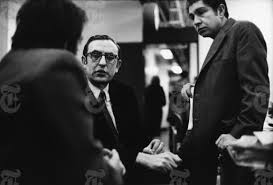|
In admirable journalistic precision, it did not take Sam Roberts long to get to the point about Arthur Gelb.
“Sheer force of personality.” Words 5 through 8. Gelb was a whirlwind, make you crazy, make you work better. He was our boss, our captor, our rabbi, and now he is gone at 90. So soon? If anybody wants to know about The New York Times – why one passionate sliver of society is paying so much attention to the current changes – it is all contained in Arthur Gelb’s obituary in today’s paper. He personified the power and the glory, the curiosity and the authority, of the Times. Just read Sam’s obit. But let me say a few personal words. I went to work for him on Jan. 2, 1973, after choosing to come back from a great job in Appalachia. Needed to get home. I was taken in by the Metro editor, long and twitchy, whom I did not know but would soon come to think of as a stork on speed. Arthur had a zillion ideas, half a dozen of which were brilliant, and he was capable of great enthusiasms and innate wisdom. “Cover Long Island like a national assignment, the way you did Appalachia,” he told me. He got it. Whenever other editors tried to change my direction, I would quote him. He loved to hear about things outside his urban experience. People fish for snappers and bluefish less than an hour from Times Square? How long has this been going on? Get photos! Write long! We’ll put it on the second front! Every day he promised 10 or 12 reporters that their literary efforts would be on the second front. The next day, from the obscurity of B17, most of the reporters wanted to throttle him. He was sometimes kind, liked to reward people, in a job that necessitated hard decisions, in a newsroom stocked with talent (and still is.) Sensational new recruits got heavy play. One year it was the wonderful Anna Quindlen. The next year it was the marvelous Alan Richman. “There goes Alan Richman,” Quindlen once quipped, but nicely. “He’s the new Anna Quindlen.” She did all right. So did Richman. So did a lot of Arthur’s people. There was one way to get through to him. I tried acting disturbed, but how would anybody tell in that setting? Grace Lichtenstein, one of our hardiest reporters, who could go anywhere, do anything, found a way to get through to Arthur. She would complain to him in the center of the newsroom – until tears started welling in her eyes. “Don’t cry! Don’t cry!” he would plea, hustling her into a conference room. She did fine. He was a big softy, under that manipulative armor. (THIS JUST IN: Check Grace's letter in the NYT Thursday:) http://www.nytimes.com/2014/05/22/opinion/arthur-gelb-of-the-times-a-maestro-in-the-newsroom.html?partner=rssnyt&emc=rss&_r=0 (GREAT MINDS THINK ALIKE; WE HAVEN'T COMPARED NOTES IN A FEW YEARS. GV.) He took care of his people. I had somebody who knew me, as long as he was in the building. It was a comforting thought. When he retired from the news operation, there was a gathering of his people, hundreds of reporters and editors who had suffered and thrived under him. Charlayne Hunter-Gault was the lead speaker, telling stories of the mythical second frontings, the weird assignments, the dead ends, the forgotten promises. In the front row, the old rascal sat there, a huge smile on his face, surrounded by his people. Yes, his smile said, I did all that. Just read Sam Roberts’ piece: http://www.nytimes.com/2014/05/21/business/media/new-york-times-editor-arthur-gelb-dies.html?_r=0 And read Pranay Gupte's piece, too. Pranay was there. http://www.livemint.com/Consumer/zgQ0MGi2WcIK9ddZDXXoIP/Arthur-Gelb-creative-tower-of-tension-of-The-New-York-Time.html
Thor A. Larsen
5/21/2014 01:40:46 pm
Wow! A very fascinating man with so many contributions in the news industy. I now understand a little better why the New York Times is so much more interesting and comprehensive ves competing newspapers.
George Vecsey
5/21/2014 03:03:09 pm
Roberts' great piece mentions Arthur's involvement in theater.
Mendel
5/22/2014 05:16:34 am
George,
George Vecsey
5/22/2014 11:48:23 am
Dear Mendel: funny, Grace Lichtenstein uses the same phrase in her letter in the NYT (I included it in my addenda above)
Mendel
5/22/2014 11:48:26 pm
George,
George Vecsey
5/23/2014 04:20:03 am
Mendel, thanks for the clarification.
Pranay Gupte
5/22/2014 06:32:18 am
Lovely piece, George. And thanks for mentioning my own tribute to Arthur. Warmest 5/23/2014 03:31:29 am
George
Mendel
5/23/2014 04:31:12 am
George, Comments are closed.
|
Categories
All
|










